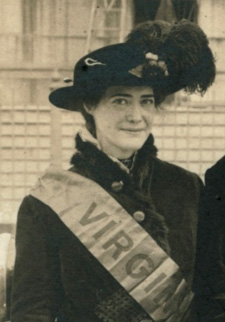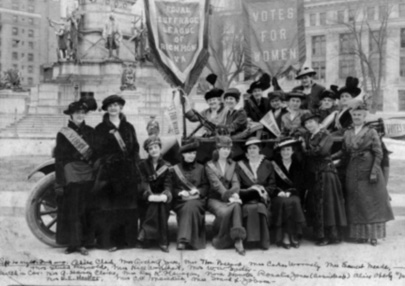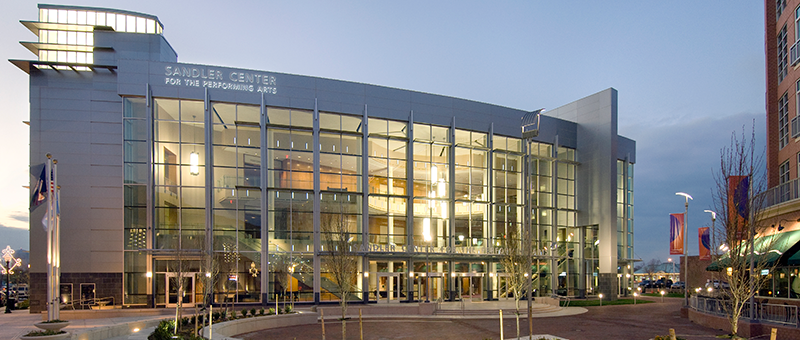Each month, HRW will honor one of today’s woman leaders and pair her with like-minded a historical woman leader who is honored and highlighted in the Women’s Monument. Adele Goodman Clark has a bronze statue in pride of place in the Voices from the Garden on the capitol square in Richmond Virginia.

Adele Goodman Clark as a suffragette pushing womens’ right to vote
Adele Goodman Clark was born in 1882 in Montgomery, Alabama to Robert Clark, a railroad worker originally from Belfast, and Estelle Goodman Clark, a Jewish music teacher originally from New Orleans.
Her family lived in New Orleans, Louisiana and Pass Christian, Mississippi before moving to Richmond, Virginia in 1894. Clark attended the Virginia Randolph Ellett School. In 1906 Adele went to the New York School of Art on a scholarship, studying under a variety of artists including Robert Henri and
William Merritt Chase.
Activism
Goodman Clark’s activist career began in 1909, when she and 18 other women, including Nora Houston, Ellen Glasgow, Lila Meade Valentine, Kate Waller Barrett, and Mary Johnston, founded the Equal Suffrage League of Virginia. She served as its secretary for one year, and also as a committee chair and head of the group’s lobby in the Virginia General Assembly. In 1910, she was a delegate to the National American Woman Suffrage Association convention in Washington, D.C. Goodman Clark and her partner Houston also set up their easels on a street corner in downtown Richmond, speaking about women’s suffrage and handing out leaflets to people who approached.
When the Art Club of Richmond dissolved in 1917, Goodman Clark and Houston opened a studio together, and two years later founded the Virginia Academy of Fine Arts and Handicrafts. In the months before the 1920 elections, when there were threats and rumors of spurious challenges against black women voters, Goodman Clark and Houston invited black leaders to their studio to plan ways to confront the issue. They decided that the white suffragists would patrol polling locations in cars. Goodman Clark and Houston continued to be involved in the interracial movement after this election. They also participated in art-related activism, campaigning for the resurrection of the Academy of Sciences and Fine Arts, which opened in 1930 as the Richmond Academy of Arts and later became the Virginia Museum of Fine Arts.

Members of the Equal Suffrage League of
Virginia, Goodman Clark far left
When women were given the vote in 1920, the Equal Suffrage League became the Virginia League of Women Voters, in which Goodman Clark was its first chair before becoming president the next year. She was its president from 1921 to 1925, and then again from 1929 to 1944. Goodman Clark was elected to the board of the National League of Women Voters in 1924 as a regional director. In 1925 she was elected Second Vice-President, a position she held until 1928.

Government and Educational Positions
In 1922 Governor E. Lee Trinkle appointed Goodman Clark to the Commission on the Simplification of State and Local Government. Four years later, Governor Harry F. Byrd Jr. appointed her to the Liberal Arts College for Women Commission, a nine-member group studying the feasibility of establishing a new liberal arts college for women in Virginia. During the 1930s, Goodman Clark worked as a field supervisor for the National Reemployment Service. She later became the Virginia Arts Project Director of the Work Projects Administration, laboring to provide employment opportunities for artists in the state. In her later years, Goodman Clark remained active in the Richmond community as a member of the Richmond Diocesan Council of Catholic Women and the Virginia Art Commission.
She was on the Virginia Arts Commission from 1941–1964, having helped establish it in 1916. Goodman Clark, who also put her campaign for women’s suffrage into her artistic work, commented that her art and her activism were related, saying, “I’ve always tried to combine my interest in art with my interest in government.”
According to the Richmond Magazine, without Adele Goodman Clark, it is unlikely that the Virginia Commonwealth University School of the Arts would exist, at least as we know it. She brought about the Virginia Commission for the Arts in 1916. Her campaign 75 years ago to build a place to make and view creative work ultimately produced the Virginia Museum of Fine Arts (VMFA). Adele Goodman Clark died at the age of 100 in 1983.
1. Kollatz, Harry (May 26, 2011). “An Artist’s Creation”. Richmond Magazine.
2. ^ Jump up to:a b c d e f g h “Biographical/Historical Information”. A Guide to the Adele Goodman Clark Papers. Virginia Commonwealth University.
3. ^ Jump up to:a b c d e “Adèle Clark (1882–1983)”. Encyclopedia Virginia. Virginia Foundation for the Humanities.
4. ^ “Oral History Interview with Adele Clark, February 28, 1964”. Oral Histories of the American South. The University of North Carolina at Chapel Hill.
5. ^ Jump up to:a b Tyler-McGraw, Marie (1994). At the falls: Richmond, Virginia and its people. University of North Carolina Press. pp. 236, 243.
6. ^ Jump up to:a b Lebsock, Suzanne (1993). “Woman Suffrage and White Supremacy: A Case Study”. In Hewitt, Nancy A.; Lebsock, Suzanne (eds.). Visible women: new essays on American activism. University of Illinois Press. p. 88.
7. ^ “Adèle Clark Papers”. Virginia Historical Society.
8. ^ Jump up to:a b Marschak, Beth; Lorch, Alex (2008). Lesbian and Gay Richmond. Arcadia Publishing. pp. 14–16.
9. ^ Mack, Charles R. (1995). Paper Pleasures: Five Centuries of Drawings and Watercolors. University of South Carolina Press. pp. 69–70.
10. ^ “Adèle Clark (1882–1983)”. encyclopediavirginia.org. Virginia Foundation for the Humanities. Retrieved March 16, 2016.

